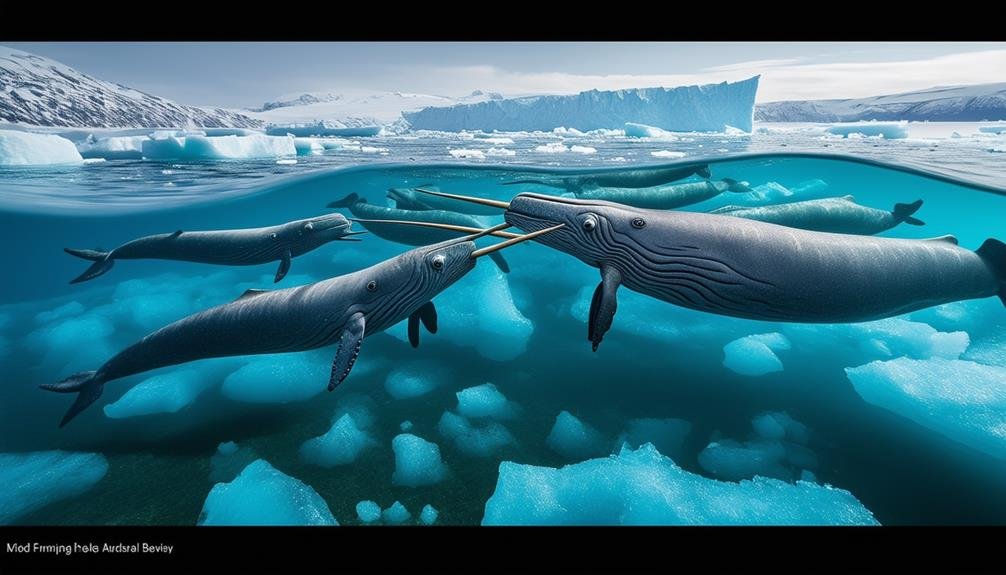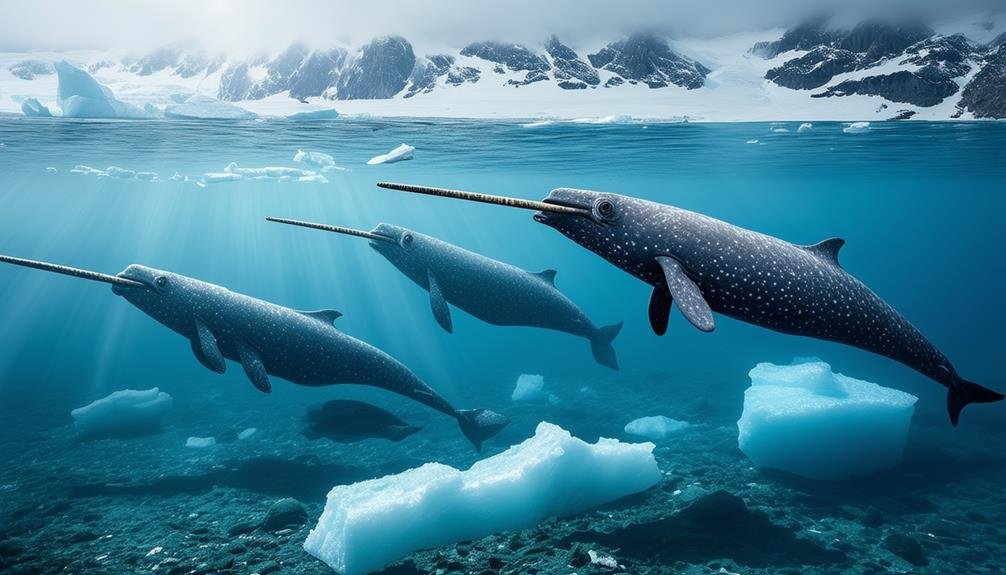Narwhals, often dubbed 'unicorns of the sea,' are unique due to their spiral tusks, which are actually extended teeth found mainly in males. These tusks, stretching up to 10 feet, have sensory pores for environmental detection. Narwhals are exceptional profound divers, capable of reaching depths of 1,800 meters, thanks to their specialized blood composition and circulatory adaptations. They live in pods, exhibit strong social bonds, and migrate seasonally across the Arctic. However, their survival is threatened by climate change, hunting, and pollution. To appreciate the full scope of what makes these creatures truly unique, there is much more to explore.
Main Points
- Narwhals possess a distinctive spiral tusk, primarily in males, earning them the nickname 'unicorns of the sea'.
- They have specialized blood and circulatory adaptations enabling deep-sea dives up to 1,800 meters in Arctic waters.
- Narwhals form strong social bonds within pods, using vocalizations and body language for communication.
- They migrate seasonally between ice-covered and coastal Arctic waters for feeding and breeding.
- Climate change, hunting, and pollution pose significant conservation challenges, impacting their habitat and populations.
Unique Physical Traits
Narwhals are distinguished by their long, spiral tusk, which is actually an extended tooth and can reach lengths of up to 10 feet, mainly in males. This tusk, earning them the nickname "unicorns of the sea," is a defining feature among toothed whales. Unlike typical teeth, the narwhal's tusk grows outward in a helical pattern, unfolding in a tight, leftward spiral over approximately five years. This unique structure is not merely ornamental but serves as a sophisticated sensory organ.
The tusk contains thousands of tiny holes that allow narwhals to sense various environmental factors within their Arctic habitat. Through these pores, narwhals can detect changes in water depth, temperature, and salinity, providing critical information for survival in their often harsh surroundings. The sensory capabilities of the tusk help narwhals in communication, locating prey, and potentially monitoring environmental changes.
Female narwhals rarely develop tusks, emphasizing a pronounced sexual dimorphism within the species. Coupled with their distinctive mottled skin and white underbelly, the narwhal's physical traits underscore their unique adaptation to the Arctic environment, distinguishing them as one of the most fascinating marine mammals.
Deep-Sea Diving Abilities
Exhibiting extraordinary physiological adaptations, the narwhal's oceanic diving capabilities enable it to reach depths of up to 1,800 meters in the frigid Arctic waters. These remarkable dives are made possible by a combination of unique adaptations tailored to their challenging marine environment.
- Blood Composition: Narwhals possess specialized hemoglobin and myoglobin in their blood, which allows for efficient oxygen storage and utilization during prolonged dives. This adaptation is essential for surviving in an environment where breathing opportunities are limited.
- Body Size and Blubber Layer: The narwhal's body size and shape are optimized for heat retention, essential for enduring the cold temperatures of their Arctic habitat. A thick blubber layer provides additional insulation, enabling these marine mammals to maintain body heat during extended periods underwater.
- Circulatory Adaptations: Arteries and veins in the narwhal's flippers run closely together, a feature that helps warm the blood as it circulates. This counter-current heat exchange system is crucial for maintaining core body temperature and function during deep dives.
These adaptations collectively enable narwhals to thrive in their unique Arctic habitat, showcasing their exceptional oceanic diving abilities and resilience in one of the planet's most extreme environments.
Social and Reproductive Behavior

While their deep-sea diving abilities are fascinating, narwhals also display equally intriguing social and reproductive behaviors within their pods. These marine mammals form pods typically consisting of up to a dozen individuals, although larger group sizes are also observed. The strong social bonds within these pods are evident through their use of vocalizations and body language for communication.
Narwhals exhibit polygynous behavior, with males competing for mating opportunities with females. This competition is a significant aspect of their social structure. Females undergo a gestation period lasting between 14 to 16 months and subsequently nurse their calves for about a year. Sexual maturity is reached at around nine years of age for females, which allows for a relatively long reproductive lifespan given that narwhals can live up to fifty years.
Below is a summary of key social and reproductive behaviors:
| Behavior | Details |
|---|---|
| Pod Size | Up to a dozen, sometimes larger |
| Social Bonds | Strong, using vocalizations/body language |
| Polygynous Behavior | Males compete for mating |
| Gestation Period | 14 to 16 months |
| Sexual Maturity | Females at around nine years |
These behaviors highlight the complex and highly social nature of narwhals in the wild.
Habitat and Distribution
Primarily inhabiting the Arctic regions, narwhals are most commonly found along the coasts and rivers of Canada, Greenland, and eastern Russia. These unique cetaceans are particularly concentrated in the northeastern regions of Canada, where they navigate the icy waters of Baffin Bay, Lancaster Sound, and Hudson Bay. Their distribution is largely influenced by the seasonal changes in the Arctic environment.
Narwhals exhibit distinct migratory patterns, moving from the deeper, ice-covered waters in the winter to the more accessible coastal waters in the summer. This seasonal migration is essential for their feeding and breeding activities. During summer, narwhals can often be seen in larger groups as they congregate in these coastal areas.
Their habitat and distribution can be summarized with the following key points:
- Primary Locations: Narwhals are mainly found in northeastern Canada, northern and eastern Greenland, Svalbard, and northern Russia.
- Migratory Behavior: They migrate between ice-covered waters in winter and coastal waters in summer.
- Group Dynamics: Typically travel in groups of 15 to 20 individuals, though larger gatherings occur in summer feeding grounds.
Climate change poses a significant threat to their habitat, affecting ice coverage and, consequently, their migratory and feeding patterns.
Conservation Challenges

The survival of narwhals in their natural habitat is increasingly jeopardized by a multitude of conservation challenges. Climate change has a significant impact on their Arctic environment, leading to the reduction in sea ice, which, in turn, increases human activity in these previously isolated regions. This human presence often results in pollution and disturbances that can harm narwhal populations.
Hunting, particularly for ivory and food by Inuit communities, remains a major threat. While this practice is culturally important, it requires careful management to guarantee narwhal populations are not unsustainably diminished. Entrapment due to shifting sea ice is another critical issue, often resulting in narwhal mortality.
Conservation Challenges
| Threats | Impact on Narwhals |
|---|---|
| Climate Change | Habitat and food source loss |
| Hunting | Population decline |
| Entrapment | Increased mortality |
| Pollution | Health and reproductive issues |
| Increased Human Activity | Habitat disturbance |
Indigenous-led conservation efforts have shown promise in addressing these challenges. By integrating traditional knowledge with modern conservation strategies, these efforts aim to create sustainable solutions for protecting narwhals and their unique Arctic habitat. Effective conservation requires collaboration among scientists, Indigenous communities, and policymakers to mitigate these threats and guarantee the long-term survival of narwhals.
Conclusion
Narwhals exhibit unique physical traits, such as their iconic tusks, and possess remarkable deep-sea diving abilities. Their social and reproductive behaviors are intricate, contributing to the species' survival in harsh Arctic environments. Narwhals inhabit specific regions, primarily in the Arctic waters of Canada, Greenland, Norway, and Russia. Despite their adaptability, they face significant conservation challenges due to climate change, habitat disruption, and human activities. Understanding these characteristics is vital for effective conservation strategies and ensuring the species' longevity.


